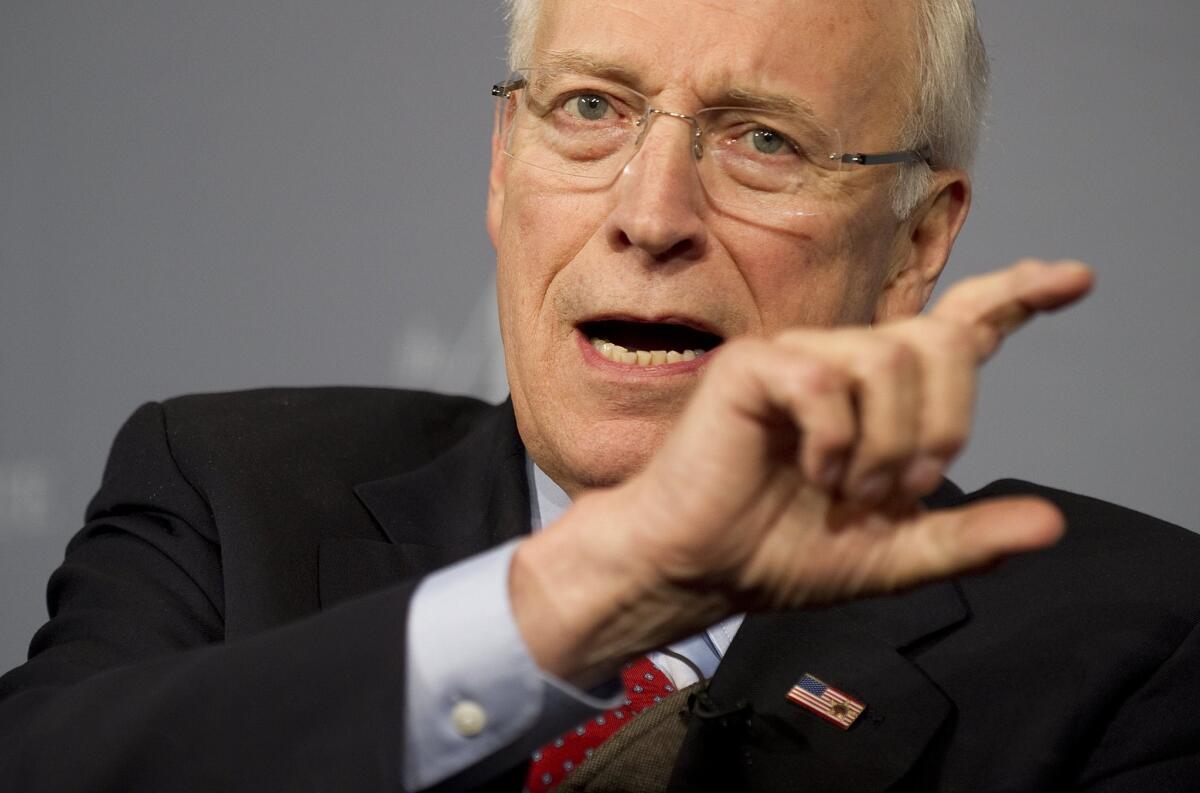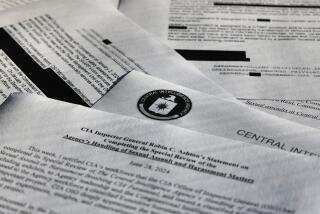Cheney on CIA interrogations: âIâd do it again in a minuteâ

Reporting from Washington â Senior Bush administration officials Sunday slammed the Senate study on the CIAâs use of brutal interrogation tactics and defended the techniques as necessary to get information from senior Al Qaeda operatives who had stopped talking to interrogators.
âIâd do it again in a minute,â former Vice President Dick Cheney said on NBCâs âMeet the Press.â âIt absolutely did work.â
The report released last week by the Democrat-led Senate Intelligence Committee has revived a decade-old debate about whether the U.S. should use coercive interrogation techniques to get information from terrorists and if such methods produce accurate and useful information.
CIA cables written at the time show that detainees had provided key information before the harsh tactics, such as waterboarding, confinement in small spaces and beatings, had been used. The study concluded that the use of torture was not effective and did not produce actionable intelligence about an imminent attack.
Cheney called the report âa cheap-shot piece of political business,â and criticized the Senate investigation for not interviewing CIA personnel. âThe report is seriously flawed,â Cheney said. âThey didnât talk to anybody who knew anything about the program. They didnât talk to anyone who was in the program.â
The Senate staff said they reviewed the transcripts of interviews with CIA staff conducted by the CIAâs inspector general.
Later on âMeet the Press,â Sen. Ron Wyden (D-Ore.) said the Democratic staff of the committee reviewed 6 million pages of documents. âThere are a mountain of contradictions,â he said.
âFacts arenât partisan,â Wyden said, adding that the Justice Department should review the new facts in the report and reconsider the departmentâs decision not to prosecute those involved in the CIAâs program.
Speaking on âFox News Sunday,â Jose Rodriguez, who helped design the detention and interrogation program as head of the CIAâs Counterterrorist Center, defended his controversial decision in 2005 to destroy tapes depicting hours of CIA interrogation sessions.
âI knew the tapes would leak some day,â Rodriguez said. He destroyed the tapes out of concern for the safety of the CIA officers whose faces appeared in the footage, he said. He was afraid that if the tapes were made public Al Qaeda would âgo after them and their families.â
âI was concerned for their safety,â he said.
âThis is one of the most highly reviewed covert action programs in the history of the agency,â Rodriguez said. âIn the end no prosecutable offenses were found â no one tortured anyone else.â
Karl Rove, who was a senior advisor and deputy chief of staff to President George W. Bush, said on âFox News Sundayâ that all of the interrogation techniques were âcarefully designedâ and approved by administration lawyers.
The Senate study details multiple instances where interrogators appeared to act outside of their legal authorities and used techniques that were not approved.
Rove denied this. He said the detainees that received ârectal rehydrationâ and ârectal feedingâ were on hunger strikes. But medical experts have said that neither technique is a legitimate medical procedure.
When it came to the use of waterboarding, a type of simulated drowning that was used on at least three senior Al Qaeda operatives, Rove said the style of waterboarding used by Japanese soldiers on prisoners during World War II was different from the technique used by the CIA.
Unlike the Japanese method, Rove said, when the CIA waterboarded detainees, the âfeet were elevatedâ to prevent the lungs from filling up with water. âVery careful standards were put in place,â Rove said.
The Senate study documents a program that was poorly managed, lost track of detainees, and created an environment in which some interrogators beat detainees, chained them to walls for days at a time and locked them into coffin-like boxes. There is no record of Bush being formally briefed by CIA officials about the program until 2006, the study states.
But Cheney said Bush was well aware of the program. Cheney was in briefings nearly six days a week with Bush and the director of the CIA at the time, George Tenet, he said. Bush âknew what we were doing; he authorized it,â Cheney said.
The Bush administration was âvery careful to stop short of torture,â Cheney said.
âTorture to me,â Cheney said, âis an American citizen on his cellphone making a last call to his four young daughters shortly before he burns to deathâ on the top floors of the World Trade Center on Sept. 11, 2001, Cheney said
Pressed on the fact that 26 of the 119 detainees in the CIAâs custody were held in error, Cheney said he was more concerned about the U.S. releasing âbad guysâ from custody. Many former detainees that have been released have returned to the battlefield. Like Abu Bakr Baghdadi, for example, who now leads the Islamic State and was once held by the U.S. military in Iraq.
One CIA detainee mistakenly held was named Gul Rahman. Rahman froze to death while chained to the floor of a CIA âblack siteâ in Afghanistan.
âI am more concerned with bad guys who were let out and released than a few that were innocent,â Cheney said. âI have no problem as long as we achieve our objectiveâ to prevent a future attack, Cheney said.
CIA Director John Brennan said Thursday during an unprecedented televised speech and news conference at CIA headquarters that there were management failures during the program and that some of the methods used were âabhorrent.â The question of whether the specific âenhancedâ interrogation techniques prodded detainees into giving up unique information is âunknowable,â Brennan said, but the CIAâs detention program as a whole was effective and helped save lives.
For more reporting on national security, follow me on Twitter @ByBrianBennett.
More to Read
Sign up for Essential California
The most important California stories and recommendations in your inbox every morning.
You may occasionally receive promotional content from the Los Angeles Times.











